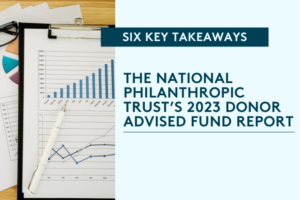8 Reasons Why Donor-Advised Fund Donors are Important Assets

September 20, 2023 | 5 min read
Donors who actively use donor-advised funds for charitable gifting can be a powerful asset in a nonprofit’s fundraising initiative. Not only is the money readily available to be sent to nonprofits, but donors are typically more willing to donate to nonprofits they are already familiar with or supporting. Understanding which donors are recurring donors that use donor-advised funds to support your nonprofit can go a long way in achieving fundraising goals year after year.
Why are these donors so important? Read on for eight ways donor-advised fund donors are an important factor in nonprofits’ fundraising goals.
- Donors are Intentional
A common misconception about donors using donor-advised funds is that they are storing money in an account for a tax break. The reality is that there’s not much of a benefit to this strategy because the donor would, at best, receive roughly 30% reduction on taxes from a charitable donation. Donors use donor-advised funds to be able to give readily, often, or long into the future. These donors are intentional about setting money aside on a regular basis so they can support causes that are making a difference.
- Donors Want to Support Charitable Causes
Donors utilizing donor-advised funds often have a cause or multiple causes they are passionate about and donate to regularly. With a donor-advised fund, donors can move money quickly to nonprofits they care about either regularly, in response to a pressing need, or to support a new initiative from the nonprofit. With a donor-advised fund, a donor is ensuring funds are set aside so they can support the causes they care about.
- They’re Recession-Proof
Generally, donor-advised funds have withstood shocks to the economy and have been recession-proof. During these timeperiods, donor-advised funds have remained steady and even supported nonprofits that demonstrated the highest need. Although some forms of donations may struggle, donor-advised funds have remained a steady source of funding during key moments. - Money is Available
When a donor puts money into a donor-advised fund, they have destined it for a charitable cause and it cannot be used for anything other than a charitable donation. The money in the account is ready and available to be sent to a nonprofit. When charitable donations are sent from a donor-advised fund, it’s often easier for the donor to allocate the money, because it has already been set aside with the intention of it going to a nonprofit. According to the NP Trust 2022 DAF Report, in 2021 charitable donations from donor-advised funds totaled $45.74 billion which was a 28.2% increase compared to 2020. Trends suggested that donor-advised funds continue to grow in popularity and will continue to make up a large portion of charitable gifting.
- Simplifies Additional Funding
When a donor is readily offering you financial support on an ongoing basis, they already have an affinity for your mission and value the work you’re doing for your community. If your nonprofit has additional needs or a crisis occurs that requires additional funding, you should first turn to donors who offer ongoing support–many of which are likely using donor-advised funds–to ask for their financial assistance. Since they are already familiar with the work you’re doing and the mission your organization is working towards, they will be more inclined to respond to your request.
- Move Quickly
In times of crisis, it’s imperative to act quickly. Money from donor-advised funds is positioned to move quickly to disburse to the intended nonprofit. While other forms of funding or monetary support are important, donor-advised fund money can be mobilized and disbursed quickly so the funds can be put to immediate use to support relief efforts your nonprofit needs.
- Built-in Networks
Although donors using donor-advised funds are an important part of fundraising, hosting events and inviting them to participate in volunteer initiatives can be an important part of advancing a nonprofit’s mission. Encouraging supporters to bring friends and family to these events and volunteer initiatives to share the experiences together can help create new advocates that feel called to support your mission.
- Workplace Wins
Over 26 million Americans work for companies that offer workplace giving programs, and many of those programs include a company match–up to a certain dollar or percentage. This matching program can almost double an employee’s donation to the nonprofit they select and it’s estimated that between $2 and $3 billion is donated with corporate matching programs. This is a powerful way to support ongoing fundraising needs throughout the year. Knowing which platforms support workplace giving and having an updated active profile on these sites, such as NPOconnect by Blackbaud, can increase your visibility to a huge group of active donors.
Donor-advised funds represent a powerful group of people who are looking to actively support nonprofits they care about. Understanding this and looking through your CRM to see who is using donor-advised funds can help your nonprofit build a better strategic fundraising plan to reach these donors.
To learn more about The Blackbaud Giving Fund, visit blackbaudgivingfund.org, or follow the organization on LinkedIn, Facebook, and Instagram for updates, news, and more.
For more information about NPOconnect or to sign up, visit https://nonprofit.yourcause.com/login/create-account.


